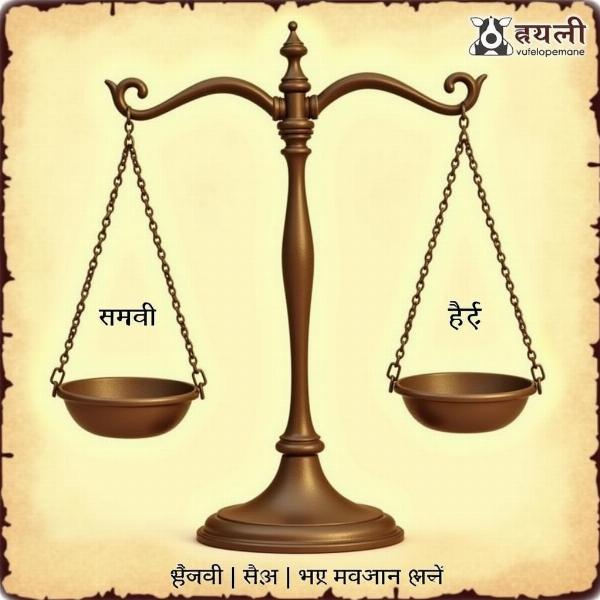Understanding the Hindi meaning of “evil” requires delving into the cultural and philosophical nuances of the language. While a direct translation might suggest words like “buraai” (बुराई) or “dushtata” (दुष्टता), the concept encompasses a broader spectrum of meaning in Hindi, reflecting India’s rich spiritual heritage. “Evil” isn’t merely the opposite of “good”; it embodies negativity, malevolence, and often a spiritual dimension.
Exploring the Nuances of “Evil” in Hindi
Hindi, unlike English, possesses a range of words that capture different facets of “evil.” “Buraai” (बुराई) is the most common and general term, encompassing anything bad or harmful. “Paap” (पाप) refers specifically to sin, actions that go against religious or moral principles. “Dushtata” (दुष्टता) describes wickedness or malice, often implying a deliberate intent to harm. “Asur” (असुर) and “rakshas” (राक्षस) are mythological terms representing demonic beings, embodying ultimate evil. Understanding these distinctions provides a deeper insight into the concept of “evil” within the Hindi language and Indian culture.
The Influence of Indian Philosophy on “Evil”
Indian philosophies, particularly Hinduism and Buddhism, offer profound perspectives on “evil.” The concept of karma plays a crucial role, linking actions to consequences and suggesting that “evil” actions lead to negative repercussions. Dharma, the principle of righteousness, provides a framework for ethical conduct and opposes “evil.” The struggle between good and evil is often depicted in Hindu mythology, with deities like Vishnu constantly battling demonic forces. This constant interplay emphasizes the importance of striving for good and overcoming “evil” within oneself and the world.
“Evil” in Everyday Hindi Conversation
In everyday conversations, Hindi speakers often use less formal terms to describe “evil.” Words like “ganda” (गंदा), meaning dirty or impure, can also carry connotations of moral “evil.” Similarly, “kharab” (खराब), meaning bad or spoiled, can refer to both physical and moral negativity. The specific word choice depends on the context and the degree of negativity being expressed.
How to Accurately Translate “Evil” into Hindi?
Translating “evil” into Hindi accurately depends heavily on the specific context. Consider the nuance you wish to convey. Are you referring to a general sense of badness, a religious sin, or a deliberate act of malice? Choosing the appropriate Hindi word will ensure your message is clear and culturally sensitive. For instance, translating “the evil villain” might use “dusht khalnayak” (दुष्ट खलनायक), while “the problem of evil” might be better rendered as “buraai ki samasya” (बुराई की समस्या).
Beyond “Buraai”: Exploring Related Concepts in Hindi
Beyond the core concept of “evil,” Hindi offers a rich vocabulary related to morality and ethics. Words like “neeti” (नीति) meaning ethics, “nyay” (न्याय) meaning justice, and “punya” (पुण्य) meaning virtuous deeds, provide a broader context for understanding “evil” within the framework of Indian values.
 Related Hindi Concepts to Evil
Related Hindi Concepts to Evil
Conclusion
Understanding the Hindi meaning of “evil” involves appreciating the cultural and philosophical tapestry woven into the language. From “buraai” to “paap” and “dushtata,” each word unveils a different layer of meaning. By exploring these nuances, we gain a deeper understanding of the concept of “evil” within the Indian context and its profound influence on language and culture. Knowing the appropriate Hindi word to use in different situations ensures effective communication and demonstrates cultural sensitivity.
FAQ
- What is the most common Hindi word for “evil”? Buraai (बुराई) is the most common and general term.
- What is the Hindi word for “sin”? Paap (पाप) refers specifically to sin.
- How do Indian philosophies view “evil”? Indian philosophies often link “evil” to karma and dharma, emphasizing the importance of righteous actions.
- What are some informal Hindi words related to “evil”? Words like “ganda” (गंदा) and “kharab” (खराब) can carry connotations of moral negativity.
- Why is context important when translating “evil” into Hindi? Context determines the specific nuance of “evil” being conveyed, leading to a more accurate translation.
- What other Hindi words are related to morality and ethics? Words like “neeti” (नीति), “nyay” (न्याय), and “punya” (पुण्य) offer a broader context for understanding “evil” within Indian values.
- Where can I learn more about Hindi translations? You can explore resources like Meaning-Hindi.in for accurate and culturally sensitive translations.
Related Articles
neem meaning in hindi
ambrosial meaning in hindi
hindi meaning of holiday
Meaning-Hindi.in is your trusted partner for professional Hindi translation services. We offer a wide range of specialized translation solutions, from business and legal documents to technical manuals and website localization. Our expert linguists ensure accurate and culturally nuanced translations for a variety of industries, including education, commerce, and law. Contact us today for all your Hindi translation needs at [email protected] or +91 11-4502-7584. Meaning-Hindi.in is committed to delivering high-quality translations that bridge language barriers and foster effective communication.